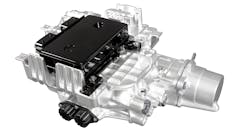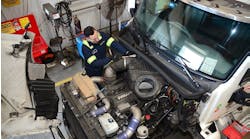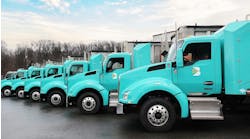Fleets, like any business, have a long list of priorities, but none may be as important as maintenance. Without trucks on the road, money is not coming in, which is why any technology that keeps things running smoothly is critical.
Automated manual transmissions (AMTs) – available for different medium and heavy duty vehicles – are primarily known for improving fuel economy, but they also have the added benefit of reducing maintenance costs.
There’s a big difference between a fully-automatic and an AMT transmission. An AMT is a manual transmission with a clutch that is controlled electronically to automatically disengage the drivetrain. Automatic transmissions use a torque converter, where the engine and drivetrain are connected by a fluid coupling.
Technologies from suppliers such as WABCO have control systems that automatically engage the vehicle’s clutch and gearshift actuation, taking into account the driver’s operation, engine torque, vehicle load and road inclination. This results in optimized gear shifting, as well as a fuel economy improvement of up to three percent for trucks and buses in congested city traffic and on long hauls alike.
This not only reduces costs, but it is critical in meeting current and future greenhouse gas standards.
Modularity
WABCO’s modular AMT control system, by way of example, is composed of several components, including: a shift-lever unit, pneumatic clutch actuator, speed sensors, gear actuator and split/range actuation technology. Its modularity adapts easily to existing gearboxes and is highly cost efficient.
AMT control technologies free drivers from frequent shifting, reducing their stress and fatigue, while allowing drivers to further concentrate on traffic conditions. Optimized gear shifting improves driver effectiveness, particularly among less experienced drivers. Plus, it enables more and better qualified drivers as the technology negates the need to engage in gearshift and clutch operations.
Furthermore, AMT control technology leads to reduced maintenance costs, as poor shifting by unskilled drivers can cause stress and damage to a vehicle’s transmission. It also reduces deterioration on the clutch and other transmission components, significantly reducing mechanical wear and lowering maintenance costs and downtime over the vehicle’s lifetime.
Additional Benefits
It’s worth noting that AMTs aren’t as expensive to replace as fully automatic transmissions. According to an industry consultancy, the medium duty truck premium for an AMT averages $600 to $3,000, increasing to $1,000 to $5,000 for heavy duty units. In comparison, the medium duty truck premium for a fully-automatic transmission averages $3,000 to $6,000, rising to $6,000 to $10,000 for heavy duty units.
AMTs also don’t require costly oil changes, whereas conventional automatics require frequent filter and lube changes, ranging anywhere from every 150,000 miles to as often as 12,000 miles. AMTs also stack up well to manual transmissions, which require regular maintenance that increases in frequency if the driver is poorly trained or inexperienced.
Suppliers, such as WABCO with its modular transmission automation system, have technologies that can be adapted to a wide range of existing manual gearboxes, enabling a simplified system that allows for better preventative maintenance and lowered maintenance costs.
Other benefits of these types of technologies can include:
- More efficient and economical driving
- Minimized driver fatigue
- Increased driver comfort
- Increased safety
- Optimized and automatically operated gearshift strategy
- Increased payload due to less weight and installation space compared to automatic transmissions
- Fuel savings of up to three percent
- Reduced clutch wear, extending component life
- Reduced maintenance costs, improving vehicle uptime
Market Penetration
In the U.S., leading commercial vehicle manufacturers now equip their heavy duty trucks with AMT control technology. The benefits AMTs provide are being realized by an increasing number of fleet operators. While manual transmissions still dominate the global commercial vehicle market, the tide is turning. In 2014, AMTs accounted for just 13 percent of the transmissions in worldwide heavy and medium duty commercial vehicles and buses. By 2019, that penetration rate is expected to rise to 18 percent and continue to climb.
According to the same industry consultancy, AMTs will experience a compound annual growth rate (CAGR) of 3.9 percent through 2025, while trucks equipped with manual transmissions will dwindle by 2.7 percent over the same stretch.
By 2025, the research firm predicts market share for manual transmissions among North American medium and heavy duty trucks will drop to 43.5 percent, while AMT share will grow to 29.4 percent.
There are several reasons for this growth, one being that AMT transmission technology has proven itself from a cost and shifting performance point of view that has led to a growth in acceptance. Additionally, operators with experience driving a manual transmission are rapidly exiting the workplace, leading to the need to hire younger people who never learned to operate a manual transmission, and for whom the transition to an AMT-equipped truck, which requires no manual shifting, is typically seamless.
Jon Morrison is the President, Americas of WABCO (wabco-auto.com), a leading global supplier of technologies and services that improve the safety, efficiency and connectivity of commercial vehicles. Founded nearly 150 years ago, WABCO continues to pioneer breakthrough innovations for advanced driver assistance, braking, stability control, suspension, transmission automation and aerodynamics.



